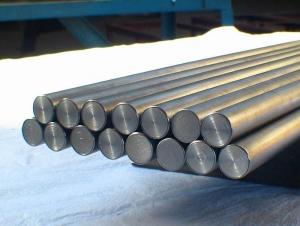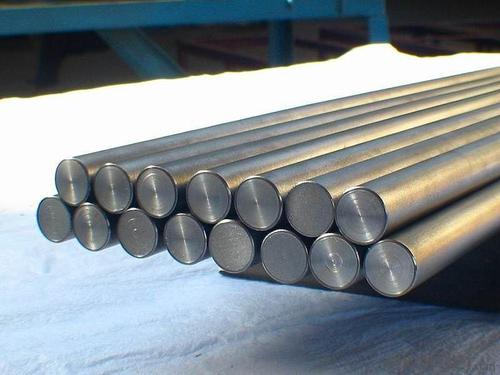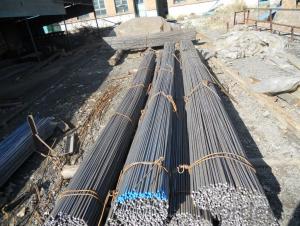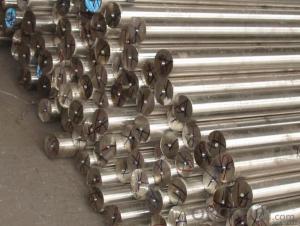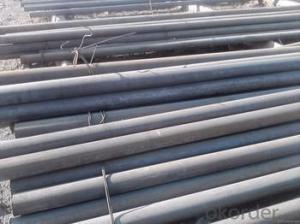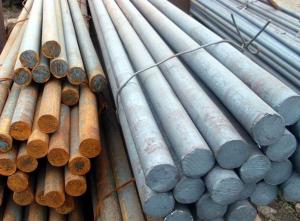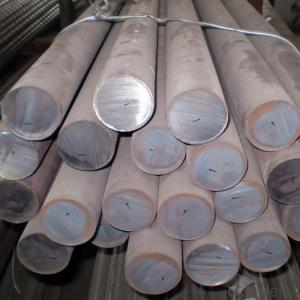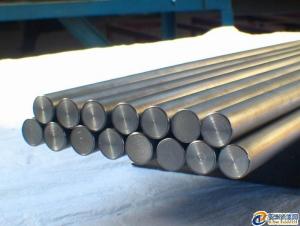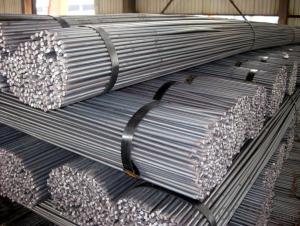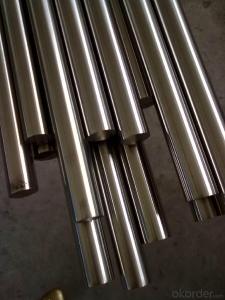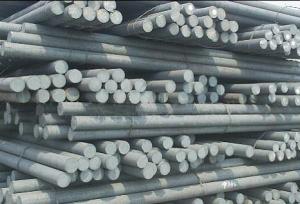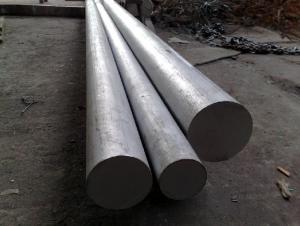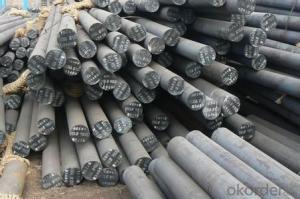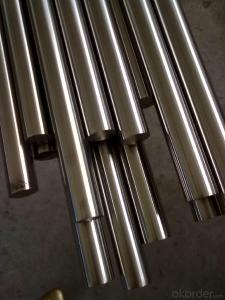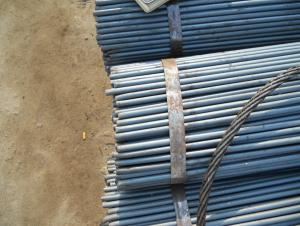Steel Round Bar 5-28mm Hot Rolled GB Q235 Q195
- Loading Port:
- China main port
- Payment Terms:
- TT OR LC
- Min Order Qty:
- 50 m.t.
- Supply Capability:
- 10000 m.t./month
OKorder Service Pledge
OKorder Financial Service
You Might Also Like
Specification
High Quality Round Bar 5-28mm Hot Rolled GB Q235 Q195
Product Applications:
1) Suitable for making various strong cutting tool abrasion resistance, impact resistance.
2) Used to produce all kinds of high hard and super hard saw blade, drill, tap, broach, gear hob and various kinds of milling cutter.
3) Used for advanced punching die, screw die, and the toughness and complicated shape of the punch, etc.
4) Is used for cold forging die and drawing mode, etc.
5) Recommended watchcase factory, screw factory and other cold stamping products industry use.
Product Advantages:
OKorder's High Quality Round Bar 5-28mm Hot Rolled GB Q235 Q195are durable, strong, and resist corrosion.
Main Product Features:
· Premium quality
· Prompt delivery & seaworthy packing (30 days after receiving deposit)
· Corrosion resistance
· Can be recycled and reused
· Mill test certification
· Professional Service
· Competitive pricing
Product Specifications:
1. Grade: GB, JIS, ASTM, EN
2. Grade: Q235, SS400, A36, S235JR
3. Diameter and mass: As below
Diameter | Mass | Diameter | Mass | Diameter | Mass |
(mm) | (kg/m) | (mm) | (kg/m) | (mm) | (kg/m) |
6 | 0.22 | 22 | 2.98 | 53 | 17.30 |
7 | 0.30 | 24 | 3.55 | 56 | 19.30 |
8 | 0.40 | 25 | 3.85 | 60 | 22.20 |
9 | 0.50 | 26 | 4.17 | 63 | 24.50 |
10 | 0.62 | 28 | 4.83 | 65 | 26.00 |
11 | 0.75 | 30 | 5.55 | 70 | 30.20 |
12 | 0.89 | 32 | 6.31 | 75 | 34.70 |
13 | 1.04 | 34 | 7.13 | 80 | 39.50 |
14 | 1.21 | 36 | 7.99 | 85 | 44.50 |
15 | 1.39 | 38 | 8.90 | 90 | 49.90 |
16 | 1.58 | 40 | 9.86 | 95 | 55.60 |
17 | 1.78 | 42 | 10.90 | 100 | 61.70 |
18 | 2.00 | 45 | 12.50 | 120 | 88.85 |
19 | 2.23 | 48 | 14.20 | 140 | 120.93 |
20 | 2.47 | 50 | 15.40 | 150 | 138.82 |
4. Material: Mild Steel
5. Heat treatment of high quality steel:
Fire: Isothermal annealing temperature is 800 ~ 880 °C, with 10 ~ 20 °C, the furnace cooling to about 600 °C, hardness above HB269.
Preheat temperature: 730-730 °C
Quenching temperature: 1190-1210 °C
Tempering temperature: 540-595 °C
Cold drawn, hardness 285 HBS
Cold drawn after annealing condition, hardness 277 HBS
Quenching methods: oil quenching, air cooling or salt bath quenching
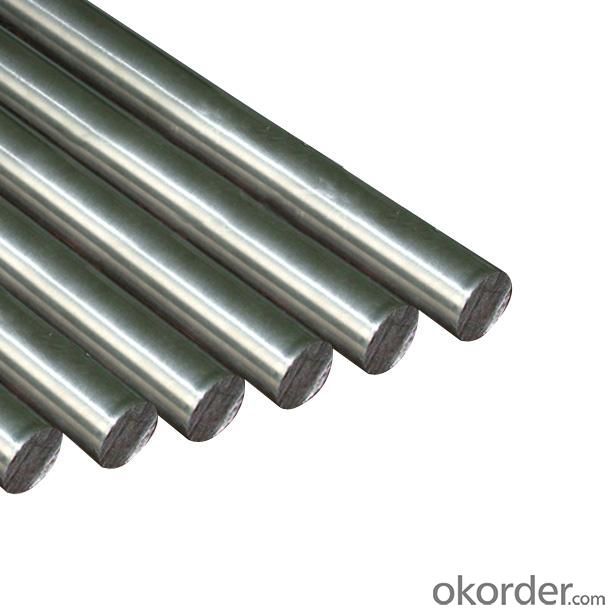
- Q: Can steel round bars be used in electrical applications?
- Steel round bars are indeed applicable for electrical purposes. Due to its excellent conductivity, steel is well-suited for grounding systems and electrical connections. In the construction of electrical transmission towers, electrical enclosures, and electrical panels, steel round bars are frequently utilized. Furthermore, in electrical installations, steel round bars offer structural support, contributing to the system's overall stability and strength. Nevertheless, it is crucial to verify that the steel round bars conform to the required electrical safety standards and possess adequate insulation measures to avert any potential electrical risks.
- Q: What are the different joining methods for steel round bars?
- There are several different joining methods that can be used for steel round bars, depending on the specific application and desired outcome. Some of the most common joining methods for steel round bars include welding, brazing, and mechanical joining. 1. Welding: Welding is a popular method for joining steel round bars. It involves melting the edges of the bars and fusing them together using heat. Various welding techniques such as arc welding, MIG welding, TIG welding, and spot welding can be used, depending on the thickness and type of steel being joined. Welding provides a strong and permanent bond, making it suitable for heavy-duty applications. 2. Brazing: Brazing is another method used to join steel round bars. It involves heating the bars and melting a filler metal that has a lower melting point than the steel. The molten filler metal is then drawn into the joint by capillary action, creating a strong bond when it solidifies. Brazing is often used when the base metals have different melting points or when a lower-temperature joining process is required. 3. Mechanical joining: Mechanical joining methods do not involve any heat or melting of the steel round bars. Instead, they rely on mechanical means to hold the bars together. Examples of mechanical joining methods include bolted connections, riveting, and clamping. These methods are often used when disassembly or adjustability is required, as they provide a non-permanent joint that can be easily undone. It is important to consider factors such as the strength requirements, environmental conditions, and the specific application when choosing a joining method for steel round bars. Each method has its own advantages and limitations, and the appropriate joining method should be selected to ensure a secure and durable bond between the round bars.
- Q: What are the different heat treatment processes for steel round bars?
- There are several different heat treatment processes that can be used for steel round bars to enhance their mechanical properties and improve their overall performance. 1. Annealing: This process involves heating the steel round bars to a high temperature and then slowly cooling them, typically in a furnace. Annealing helps to relieve internal stresses, improve ductility, and refine the grain structure of the steel. 2. Normalizing: Normalizing is a heat treatment process that involves heating the steel round bars to a temperature above the critical range, followed by air cooling. This process helps to refine the grain structure, improve machinability, and enhance the mechanical properties of the steel. 3. Quenching and tempering: Quenching is a rapid cooling process that involves immersing the heated steel round bars into a quenching medium, such as oil or water, to rapidly cool them. This process results in the formation of a hard and brittle structure called martensite. To reduce the brittleness and improve the toughness of the steel, tempering is performed by reheating the quenched steel to a specific temperature and then cooling it. This process helps to improve the overall strength, hardness, and toughness of the steel. 4. Stress-relieving: Stress-relieving is a process that involves heating the steel round bars to a specific temperature below the critical range and holding it at that temperature for a certain period of time. This process helps to reduce residual stresses that may have developed during previous manufacturing processes, such as machining or welding. Stress-relieving improves the dimensional stability and reduces the risk of distortion or cracking in the steel round bars. 5. Induction hardening: Induction hardening is a specialized heat treatment process that involves selectively heating the surface of the steel round bars using high-frequency induction currents. This process quickly raises the temperature of the surface to a point where it can be hardened by quenching. Induction hardening is commonly used to increase the wear resistance and hardness of the surface while maintaining the toughness and ductility of the core of the steel round bars. These are some of the most common heat treatment processes used for steel round bars. The selection of the appropriate heat treatment process depends on the desired mechanical properties, intended application, and specific requirements of the steel round bars.
- Q: How are steel round bars used in the manufacturing of hydraulic cylinders?
- Steel round bars are commonly used in the manufacturing of hydraulic cylinders as they provide the necessary strength and durability required for these high-pressure systems. These bars are machined, shaped, and precision-ground to specific dimensions, which are then used to create the cylinder barrel, piston, and other critical components. The steel round bars play a crucial role in ensuring the structural integrity and overall performance of the hydraulic cylinder, allowing it to withstand the forces and pressures involved in various industrial and mobile applications.
- Q: Can steel round bars be used in the manufacturing of couplings?
- Yes, steel round bars can be used in the manufacturing of couplings.
- Q: What are the advantages of using nickel-zinc alloy steel round bars?
- Nickel-zinc alloy steel round bars offer numerous benefits. Firstly, they possess a remarkable strength-to-weight ratio, making them ideal for applications that prioritize durability and strength. This allows for the construction of lighter structures without compromising on performance. Secondly, nickel-zinc alloy steel round bars outperform other steel types in terms of corrosion resistance. This makes them perfect for use in harsh environments where exposure to moisture, chemicals, or extreme temperatures is common. Furthermore, the corrosion resistance properties of nickel-zinc alloy steel contribute to its longevity and ability to withstand the test of time. In addition, nickel-zinc alloy steel boasts excellent weldability and machinability, making it easy to work with and shape into various forms. This versatility allows for the creation of intricate designs and structures, making it a popular choice in the construction and manufacturing industries. Moreover, nickel-zinc alloy steel round bars exhibit favorable thermal and electrical conductivity properties. This makes them suitable for applications that require efficient heat or electricity transfer, such as in the production of electrical components or heat exchangers. Lastly, nickel-zinc alloy steel is renowned for its resistance to fatigue and wear, making it suitable for applications involving repetitive or high-stress operations. This ensures that structures or components made from nickel-zinc alloy steel maintain their performance and integrity over extended periods. To summarize, the advantages of nickel-zinc alloy steel round bars include a high strength-to-weight ratio, superior corrosion resistance, excellent weldability and machinability, favorable thermal and electrical conductivity, and high resistance to fatigue and wear. These properties establish nickel-zinc alloy steel as a reliable and versatile material for a wide range of applications.
- Q: What is the maximum nitrogen content allowed for steel round bars?
- The maximum nitrogen content allowed for steel round bars varies depending on the specific steel grade and application requirements. However, in general, the nitrogen content is typically limited to around 0.025-0.035% to maintain the desired mechanical properties and avoid detrimental effects on the material's performance.
- Q: Can steel round bars be polished?
- Yes, steel round bars can be polished. Polishing steel round bars involves using abrasive materials, such as sandpaper or polishing compounds, to remove any imperfections or rough surfaces on the bar's surface. This process can be done by hand or with the help of machinery specifically designed for polishing metals. The end result is a smooth and shiny surface on the steel round bar. However, it is important to note that the type of steel and the desired finish will determine the specific polishing techniques and materials required.
- Q: What are the different types of steel round bar shapes?
- There are several different types of steel round bar shapes available, each with its own unique characteristics and applications. Some common types include: 1. Round: This is the most basic and widely used shape for steel round bars. It is cylindrical in shape and is used in a variety of industries, including construction, manufacturing, and automotive. 2. Square: Square steel round bars have four equal sides and are often used in applications where a strong, sturdy shape is required. They are commonly used in construction, architectural designs, and machinery. 3. Hexagonal: Hexagonal steel round bars have six sides, giving them a unique shape. They are often used in applications where high strength and resistance to corrosion are required. Hexagonal bars are commonly used in industries such as aerospace, defense, and oil and gas. 4. Flat: Flat steel round bars have a rectangular cross-section with a flat top and bottom surface. They are often used in applications where a wide, flat surface is required, such as construction, machinery, and manufacturing. 5. Half Round: Half-round steel round bars have a semicircular shape with a flat bottom surface. They are commonly used in applications such as handrails, fencing, and decorative purposes. 6. D-shaped: D-shaped steel round bars have a flat bottom surface and a curved top surface, resembling the letter "D". They are often used in applications where a strong, yet lightweight shape is required, such as automotive frames and chassis. These are just a few examples of the different types of steel round bar shapes available. The choice of shape depends on the specific requirements of the application, including strength, durability, corrosion resistance, and aesthetic appeal.
- Q: How do steel round bars perform under vibration or resonance?
- Steel round bars generally perform well under vibration or resonance due to their high strength and stiffness. The inherent properties of steel, such as its high modulus of elasticity and low damping characteristics, make it an ideal material for applications that involve vibration or resonance. When subjected to vibration or resonance, steel round bars tend to exhibit minimal deformation or deflection. This is because steel has a high natural frequency, which allows it to resist the excitation caused by external forces or vibrations. The high stiffness of steel also helps in maintaining its shape and integrity under these conditions. Furthermore, steel round bars have good fatigue resistance, which means they can withstand repeated loading and unloading cycles without significant degradation in performance. This is especially important in applications where the material is subjected to cyclic loading or vibrations over an extended period. However, it is worth noting that the performance of steel round bars under vibration or resonance can be influenced by factors such as the design of the structure, the applied loads, and the frequency and amplitude of the vibrations. In some cases, additional measures, such as damping materials or isolation systems, may need to be implemented to mitigate the effects of vibration or resonance on steel round bars. Overall, steel round bars are known for their excellent performance under vibration or resonance, making them a popular choice in various industries, including construction, automotive, and aerospace. Their high strength, stiffness, and fatigue resistance make them reliable and durable materials for applications that involve dynamic loads or vibrations.
Send your message to us
Steel Round Bar 5-28mm Hot Rolled GB Q235 Q195
- Loading Port:
- China main port
- Payment Terms:
- TT OR LC
- Min Order Qty:
- 50 m.t.
- Supply Capability:
- 10000 m.t./month
OKorder Service Pledge
OKorder Financial Service
Similar products
Hot products
Hot Searches
Related keywords
